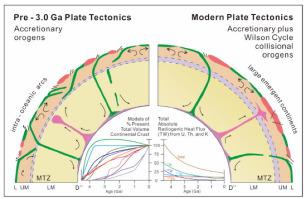当前位置:
X-MOL 学术
›
Precambrian. Res.
›
论文详情
Our official English website, www.x-mol.net, welcomes your feedback! (Note: you will need to create a separate account there.)
Onset of Plate Tectonics by the Eoarchean
Precambrian Research ( IF 3.8 ) Pub Date : 2021-01-01 , DOI: 10.1016/j.precamres.2020.105980 Brian F. Windley , Tim Kusky , Ali Polat
Precambrian Research ( IF 3.8 ) Pub Date : 2021-01-01 , DOI: 10.1016/j.precamres.2020.105980 Brian F. Windley , Tim Kusky , Ali Polat

|
Abstract One of the most contentious areas of Earth Science today is when, or whether or not modern-style plate tectonics was in operation in the Archean Eon. In this review we present evidence that the onset of plate tectonics was not at 3.2 Ga, as popularly conceived, but was in operation during the Eoarchean by at least ca. 4.0 Ga. Following a review of the main Eoarchean supracrustal belts of the world, constrained by relevant geochemical/isotopic data, we present evidence that suggests that from at least ca. 4.0 Ga Earth produced considerable juvenile mafic crust and consequent island arcs by Accretionary Cycle Plate Tectonics. From ~3.2 Ga there was a gradual transition in geodynamics to more abundant active continental margin magmatism in the form of voluminous TTGs and sanukitoids. From 3.2 Ga to 2.5 Ga juvenile oceanic crust and arcs continued to form, accompanied by more active continental margin magmatism until ~2.7–2.5 Ga, by which time there were sufficient crustal rocks to amalgamate into incipient large continents, the fragmentation of which started the first complete classical Wilson Cycle Plate Tectonics of breaking apart and re-assembling large continental masses. In other words, there were two types of plate tectonics in operation in the early Earth, Accretionary Cycle Plate Tectonics and Wilson Cycle Plate Tectonics, but Wilson Cycle type plate interactions only became more common after contiguous continental landmass became voluminous and extensive enough around 2.7–2.5 Ga. Failure to realize this dual mechanism of continental growth may lead to erroneous ideas such as “plate tectonics started at 3.2 Ga”, or “mantle plumes generated early Archean magmatic rocks.” We present new geochemical data that together with lithological and structural relationships, negate the various plume-type speculations including stagnant lids, heat pipes, and mushy-lid tectonics. It is interesting to consider that the way Earth’s crust developed in the first Gigayear of the geological record continued later, albeit in more advanced forms, into the Phanerozoic, where we can still recognize Accretionary Cycle Plate Tectonics and orogens still with short boundaries in examples including the Altaids of Central Asia, the Arabian-Nubian Shield, the Japanese Islands, and in incipient form in Indonesia, as well as Wilson Cycle Plate Tectonics that leads inexorably to continental collisions as in the Alpine-Himalayan orogen with its long plate boundaries. We recommend this holistic view of crustal growth and the evolution of continents that leads to a robust, viable, and testable model of Earth evolution.
中文翻译:

始太古代板块构造的开始
摘要 当今地球科学最有争议的领域之一是现代板块构造何时或是否在太古宙中运作。在这篇综述中,我们提供了证据表明板块构造的开始并不像人们普遍认为的那样在 3.2 Ga,而是在始太古代期间至少大约在 3.2 Ga 开始运行。4.0 Ga。在回顾了世界上主要的始太古代上地壳带之后,受相关地球化学/同位素数据的限制,我们提出的证据表明,至少从大约 4.0 Ga 地球通过增生旋回板块构造产生了相当多的新生基性地壳和随之而来的岛弧。从~3.2 Ga,地球动力学逐渐过渡到更丰富的活动大陆边缘岩浆作用,以大量 TTG 和 sanukitoids 的形式存在。从 3.2 Ga 到 2。5 Ga 幼年洋壳和弧继续形成,伴随着更活跃的大陆边缘岩浆活动直到~2.7-2.5 Ga,此时有足够的地壳岩石合并成初期的大大陆,其破碎开始了第一个完整的经典威尔逊分裂和重新组装大型大陆块的循环板块构造。换句话说,地球早期有两种类型的板块构造在运行,增生旋回板块构造和威尔逊旋回板块构造,但威尔逊旋回类型的板块相互作用只有在邻近大陆陆块在 2.7- 2.7- 左右变得足够大和足够广泛后才变得更加普遍。 2.5 Ga。未能认识到这种大陆生长的双重机制可能会导致“板块构造始于3.2 Ga”等错误观点,或“地幔柱产生了早期太古代岩浆岩。” 我们提供了新的地球化学数据,连同岩性和结构关系,否定了各种羽状类型的推测,包括停滞盖、热管和糊状盖构造。有趣的是,地壳在地质记录的第一个 Gigayear 中的发展方式在后来继续发展,尽管形式更先进,进入显生宙,在那里我们仍然可以识别增生旋回板块构造和造山带仍然具有短边界的例子,包括中亚的阿尔泰山脉、阿拉伯-努比亚地盾、日本群岛以及印度尼西亚的初期形式,以及不可避免地导致大陆碰撞的威尔逊旋回板块构造,如具有长板块边界的高山-喜马拉雅造山带。
更新日期:2021-01-01
中文翻译:

始太古代板块构造的开始
摘要 当今地球科学最有争议的领域之一是现代板块构造何时或是否在太古宙中运作。在这篇综述中,我们提供了证据表明板块构造的开始并不像人们普遍认为的那样在 3.2 Ga,而是在始太古代期间至少大约在 3.2 Ga 开始运行。4.0 Ga。在回顾了世界上主要的始太古代上地壳带之后,受相关地球化学/同位素数据的限制,我们提出的证据表明,至少从大约 4.0 Ga 地球通过增生旋回板块构造产生了相当多的新生基性地壳和随之而来的岛弧。从~3.2 Ga,地球动力学逐渐过渡到更丰富的活动大陆边缘岩浆作用,以大量 TTG 和 sanukitoids 的形式存在。从 3.2 Ga 到 2。5 Ga 幼年洋壳和弧继续形成,伴随着更活跃的大陆边缘岩浆活动直到~2.7-2.5 Ga,此时有足够的地壳岩石合并成初期的大大陆,其破碎开始了第一个完整的经典威尔逊分裂和重新组装大型大陆块的循环板块构造。换句话说,地球早期有两种类型的板块构造在运行,增生旋回板块构造和威尔逊旋回板块构造,但威尔逊旋回类型的板块相互作用只有在邻近大陆陆块在 2.7- 2.7- 左右变得足够大和足够广泛后才变得更加普遍。 2.5 Ga。未能认识到这种大陆生长的双重机制可能会导致“板块构造始于3.2 Ga”等错误观点,或“地幔柱产生了早期太古代岩浆岩。” 我们提供了新的地球化学数据,连同岩性和结构关系,否定了各种羽状类型的推测,包括停滞盖、热管和糊状盖构造。有趣的是,地壳在地质记录的第一个 Gigayear 中的发展方式在后来继续发展,尽管形式更先进,进入显生宙,在那里我们仍然可以识别增生旋回板块构造和造山带仍然具有短边界的例子,包括中亚的阿尔泰山脉、阿拉伯-努比亚地盾、日本群岛以及印度尼西亚的初期形式,以及不可避免地导致大陆碰撞的威尔逊旋回板块构造,如具有长板块边界的高山-喜马拉雅造山带。



























 京公网安备 11010802027423号
京公网安备 11010802027423号